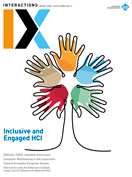Authors:
Elizabeth Murnane
Human biology's complex, dynamic inbodied processes are inextricably linked to what we have called the circumbodied. In particular, light is a key circumbodied environmental factor that affects each cell in our body, presenting multiple dimensions for an inbodied interaction designer considering the body as a site of adaptation. For instance, circumbodied light helps us consider qualities of light and darkness (intensity, frequency) and foregrounds temporality as a factor. Body clocks, rhythms, and associated design opportunities are this article's topics of discussion.

Each of our inbodied systems has, in essence, a clock. Specifically, cellular clocks interact with each other (orchestrated by the suprachiasmatic nucleus, or SCN—the master clock in our brain) to generate oscillations in gene expression. This successive gene activation forms a cycle, with the initial activation of a gene regulated by the last gene in the sequence, creating an auto-regulatory feedback loop that takes about 24 hours, in accordance with the Earth's daily light-dark cycle. These cycles are therefore referred to as circadian rhythms (circa: about, diem: a day).
Preciseness of these rhythms is maintained by a process known as entrainment, whereby the SCN uses external information (e.g., light, which specialized cells in the retina pass to the brain) in order to keep our body clocks synchronized with changes in our environment. Our individual differences, both in terms of genetics and response to environmental changes, are also important to note. Different circadian phenotypes (or chronotypes) exist and show variability in the phase and amplitude of their rhythms. A common distinction is made between early and late chronotypes (early birds and night owls)—though chronotype is not binary but rather lies on a continuous spectrum from extreme early to extreme late. Demographic factors such as age, ethnicity, and gender are known to influence chronotype, which also shifts over the lifespan.
Altogether, we can see how inbodied concepts are exemplified by our circadian system, as it is regulated by a combination of endogenous (inbodied) and environmental (circumbodied) factors and kept synchronized through behavioral (embodied) actions, such as when we expose ourselves to light and make choices related to eating, moving, and sleeping. This brief chronobiological case study also highlights the in5's principle of holism, as each of the in5 fundamental MEECS processes (see article on tuning in this section) exhibit or entrain circadian rhythms through a continuous interplay.
Designing from this perspective therefore opens up numerous ways to explore monitoring, stabilizing, and helping individuals to live in better alignment with their innate biological rhythms and, in turn, to experience enhanced well-being and less disease. A specific direction that stands out is sleep-support tools, which could move away from largely generic recommendations. For example, by translating personal data streams into behavioral biomarkers of caffeine-related traits, future systems could provide a caffeine cut-off window tuned to a user's predicted genetic response to intake. Similarly, users could be provided with chronotype-tailored napping opportunities that help stabilize rather than disrupt sleep. We could also move beyond the current focus on only sleep timing and duration and instead aim to improve chronobiologically relevant metrics such as social jet lag and midsleep stability. For instance, based on the current time, the user's past sleep-wake data, and her known future schedule constraints, an adaptive system could provide optimal sleep schedules to maximize stability across days.
Beyond sleep, personalized tools could assist users in scheduling light exposure or meals at the times that would help restabilize their circadian systems, while chronobiology-aware fitness tools could help a person explore and determine the optimal type, intensity, and duration of exercise to perform at a particular time of day. Chrono-intelligent calendars could likewise assist an individual user in identifying when to perform cognitively intensive versus lightweight tasks, in harmony with other in5 elements, while social features could go beyond considering mutual availability to additionally consider if most participants are likely to be closer to peak alertness. Professional or classroom applications similarly focused on engagement could help pair collaborators or form teams whose members are synchronized in terms of chronotype and performance patterns.
Numerous other areas are also ripe for attention, such as exploring ways to capture chronobiological data and determining appropriate evaluation strategies. All in all, inbodied interaction helps give us a roadmap for traversing this rich design space for chronobiology-aware and adaptive technology.
Elizabeth Murnane is a postdoctoral scholar in computer science at Stanford University. She conducts research in human-computer interaction, informatics, social computing, and ubiquitous computing, aiming to develop technologies that empower people in managing various aspects of their daily lives and well-being, on both personal and collective levels. [email protected]
Copyright held by author. Publication rights licensed to ACM.
The Digital Library is published by the Association for Computing Machinery. Copyright © 2020 ACM, Inc.









Post Comment
No Comments Found